
Lifestyle

Movement – a great way to relieve stress
The war in Israel and South Africa’s hostile response; rising global antisemitism; the increasing demands of everyday life. It’s not hard to understand why our stress levels are skyrocketing. That’s why we are increasingly seeking alternative ways to deal with our anxiety – through movement.
Whether you’re moving through the water, in a dance or Yoga studio, or in a “smash room”, you’re not only getting a workout, you’re also significantly diminishing stress.
“More and more people have been seeking new and different vehicles to relieve their stress as well as to increase the level of joy that they experience in their lives,” says physiotherapist and aquatic exercise instructor Stacey Lewis. “Water, especially the swimming pool, creates images of fun and playfulness, which is an element that we sometimes miss in today’s stressful world.”
Not for old fogies in bathing caps, aquatic exercise is gaining popularity. “It’s a myth that aquatic exercise classes are just a ‘gentle float’ for octogenarians,” says Lewis. “One can get a real workout and release plenty of stress and pain-relieving endorphins in the water while simultaneously cushioning your joints.” You also get the added social benefits that come with exercising in a group and, most importantly, the benefit of completely switching off from technology.
Aquatic exercise boosts physical and mental health, says Lewis. “It’s been found to have beneficial effects on neuromuscular conditions, arthritis, chronic pain, athletic conditioning, and even balance, and there’s evidence that aquatic exercise has a positive effect on anxiety and depression.”
Not only does exercise improve cardiovascular health, it also relieves stress by helping to release endorphins. Water adds another dimension in that it causes the release of endocannabinoids, which also contribute towards stress relief, says Lewis. “What’s more, exercise in warm water relaxes the muscles and has been shown to assist with sleep.”
Adding music to the mix elevates the mood-enhancing nature of aquatic exercise, she says. “Exercising to music has been shown to activate the brain’s limbic system, which has a spin-off effect of triggering the release of serotonin, the feel-good hormone.”
Also marrying music with exercise, Nia is about finding joy and connection through movement, says Kim Hatchuel. The co-owner of Johannesburg-based Nia studio, Studio Kairos, Hatchuel says that the fitness classes she’d tried before always felt either too rigid or too demanding. “What I found in Nia was way more holistic, and nurtured my body and my mind. This wasn’t just a fitness class or a way to burn calories; it was a community.”
All about moving in ways that feel good, Nia is mix of dance arts (modern dance, jazz, and Duncan Dance), martial arts (Tai Chi, Tae Kwan Do, and Aikido), and healing arts (Feldenkrais, Alexander Technique, and Yoga), Hatchuel says. “Nia is done barefoot, which made me feel more grounded and connected to my movements, aligning with its emphasis on joyful and expressive movement.”
This improves balance, stability, and alignment as the feet can spread out naturally. “Without the restriction of shoes, the feet and ankles can move more freely, which strengthens the muscles, tendons, and ligaments in the feet and lower legs,” she says.
Nia also focuses on mindfulness, encouraging participants to immerse themselves in the present, reducing anxiety. “Mentally, Nia became my sanctuary,” says Hatchuel. “The practice of mindful movement and deep breathing reduced my stress levels. I found myself feeling more joyful and emotionally balanced. The creative expression allowed me to release pent-up emotions, leaving me with a profound sense of peace.”
Creating a sense of peace is also core to Yoga and Pilates. “Pilates and Yoga are both low-impact exercises designed to teach people how to move correctly to better function in our daily movements,” says Kelly Fullerton.
Fullerton, the owner of Dynamic Posture Pilates, which offers Pilates and Yoga classes, says Pilates involves a series of stretching, strengthening, and breathing exercises that engage your core muscles, thereby releasing tension. Yoga, on the other hand, activates the body’s relaxation response and revolves around holding poses and practicing breathing techniques and meditation to improve flexibility, balance, and strength.
“Creating mind-body awareness, both practices can be highly effective for stress management due to their focus on physical postures, breathing techniques, and mental concentration,” Fullerton says. “By focusing on the moment, participants unlock their full potential, reduce stress, and improve their overall well-being,” she says. “Engaging in these practices provides a mental break from stressful thoughts and situations.”
Regularly doing Yoga or Pilates can also improve sleep quality, which is key to stress management. “Both practices also promote self-awareness,” Fullerton says, “helping you recognise stress triggers and develop coping strategies. The mental toughness and resilience developed through movement can be applied to other areas of life, helping individuals to approach challenges with a growth mindset and overcome obstacles with greater ease.”
While Yoga and Pilates are slow and intentional ways to exercise and relieve stress, sometimes one needs a less sedate outlet. The growing popularity of venues that allow participants literally to break things is testament to the need for a purely physical form of stress release. One such venue, founded by Janice Ogin, is the Smash Room, which allows participants to smash broken appliances in a controlled environment.
“There’s no judgement. You can just let out all of that frustration that has built up over time,” says Ogin. “We encourage people to let go of the negative energy that can make them sick. Once you have smashed something up, you feel incredible. It helps you to let go of the past, offering a new beginning.”
Undoubtedly therapeutic, the act of smashing something releases endorphins, giving one the energy needed to face the world again. Offering both a physical and mental workout, participants smash at their own pace during 30-minute sessions. The Smash Room offers a form of release, not violence, says Ogin, who is working to dispel misconceptions.
“You take what you need from it,” she says. “We’ve had people doing it for fun, as is the case with team building or birthday parties, to those navigating the stress and trauma of rape, bullying, or breakups. There’s so much pressure on everyone these days, from school to the workplace. The Smash Room provides an escape to let go of such pressure and negativity.”










